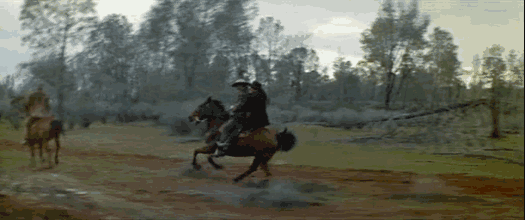Vehicle Anachronism and the Consolation of Anthony Mann's Man of the West
Stagecoach mocks me. An age ago I made a mistake. I edited an article and I cut too far. The article examined the history of what I refer to as 'travelling shots,' which are shots created by sticking a camera to a moving vehicle and filming whatever passes. My core argument was that thanks to our own everyday experience of vehicle travel, we are unable to disassociate travelling shots from a vehicular perspective. One piece of evidence for this is period films. Bar particular exceptions to the rule, audiences and filmmakers don't want anachronistic intrusions into the world. This is obviously true for the explicit diegetic anachronisms, but it is also true for the implicit diegesis.
Audiences accept some filmmaking anachronisms, there is minimal complaint regarding 35mm cameras shooting knights. We have internalised them as part of the given cinematic apparatus, and can ignore them. Then there are the cinematic choices that haven't been normalised. The blown-out whites of digital SD or the shakiness of handheld camerawork, equally, jar period filmmaking. Either technologically or creatively we associate such visuals with choices being made off-screen, we link the non-diegetic to an implicit diegesis. Now part of the film world, they are anachronistic. In that article, I argued that the travelling shot is another deviant shot, the distinct vehicle traces of their origins leave their mark. Worse, the travelling shot is often used to evoke an off-screen gaze, purposeful or contemplative, reinforcing the link between diegesis and non-diegesis. Accordingly, this deviance dictates their use within period films. They don't appear. And when they do appear, their integration is revealing. Filmmakers work to diegetically ground the source of period travelling shots: if a travelling shot appears, either careful decoupage makes the alleged vehicle source immediately apparent, or the period vehicle heavily frames the shot and the ancient motion of the vehicle is exaggerated to the point of parody, each bump a seesaw. Typically both.
The only type of vehicle shot that doesn't encounter this grounding is the helicopter shot. If properly stabilised, the helicopter shot is accepted as part of our neutral cinematic apparatus.1 I would argue that the helicopter's distinctly non-everyday view, in combination with its flexibility of movement, allows audiences to ignore its presence. It's this that allows the continual presence of helicopter shots into Peter Jackson's The Lord of the Rings trilogy.
But all of this is untrue. There is another way travelling shots may appear in period films: if the shot directly parallels the movement of the subject. Take for instance, the chase sequence of John Ford's Stagecoach (1939), it is almost entirely shot as travelling shots as Ford's camera tracks the coach and articulates its relationship to the equally fast horsemen of the attacking Apache.2 Necessity permits anachronism. If you pay close enough attention, you will even notice the tyre tracks left behind as the implicit diegetic truck encroaches upon the explicit diegesis of the frontier. This particular form of parallel travelling shot can appear because the content distracts from the camera movement and because the content temporarily justifies the movement--here is something that can move as fast as a car. Since I trimmed my article of this observation, period films have been ruined for me. Any hint of a chase leaves me braced to be proved wrong once again.
Man of the West (1958) consoles me. To the story to start, a robbery takes place. A train robbery. Aided by a gunman on board, a band of horsemen ambush a train carrying Gary Cooper as it refuels. To escape this attack, the train takes off down the tracks.3 The robbers give chase, trying to execute their plan. In this situation, convention allows galloping horses to be depicted using anachronistic truck travelling shots. Anthony Mann could have broken down the sequence to take advantage of this: plan cheval shots that show the robbers' glances and expressions, truck shots that run parallel to the train and show the train guards' positioning, achieving something similar to the sequences Ford produced.Instead, Mann grounds the chase sequence. Once the ambush starts, suspense established, Mann privileges the tangental point-of-view of the train's guards. Only when the train moves does the camera move.4 Throughout the sequence, any travelling shot that tracks the movement of the horsemen has its source grounded in the world's diegesis, thanks to the train providing a foreground frame. Mann's dynamic framing sees Man of the West avoiding even the mild anachronism of the parallel travelling shot.
As the chase closes, Mann acknowledges his range of possibilities. The final shot begins as a Ford-esqueparallel travelling shot that tracks the horsemen, unframed by any diegetic vehicle, before it pans left to reveal the train that grounds the camera's movement in its time.5

